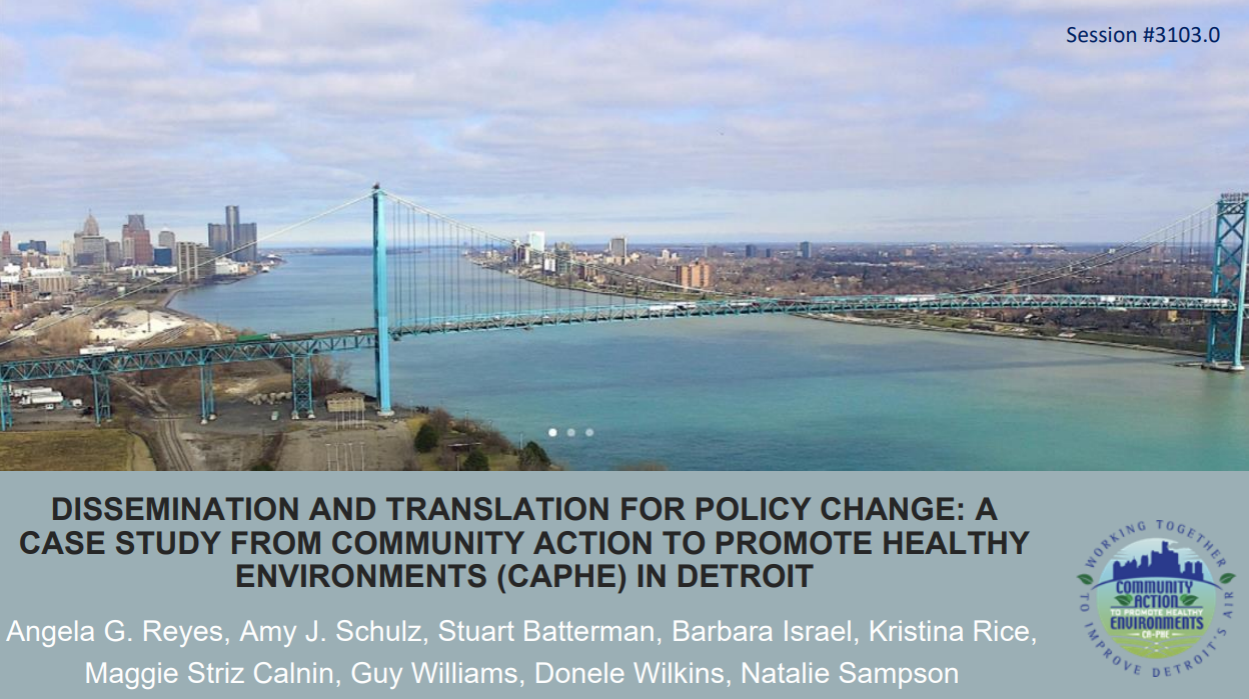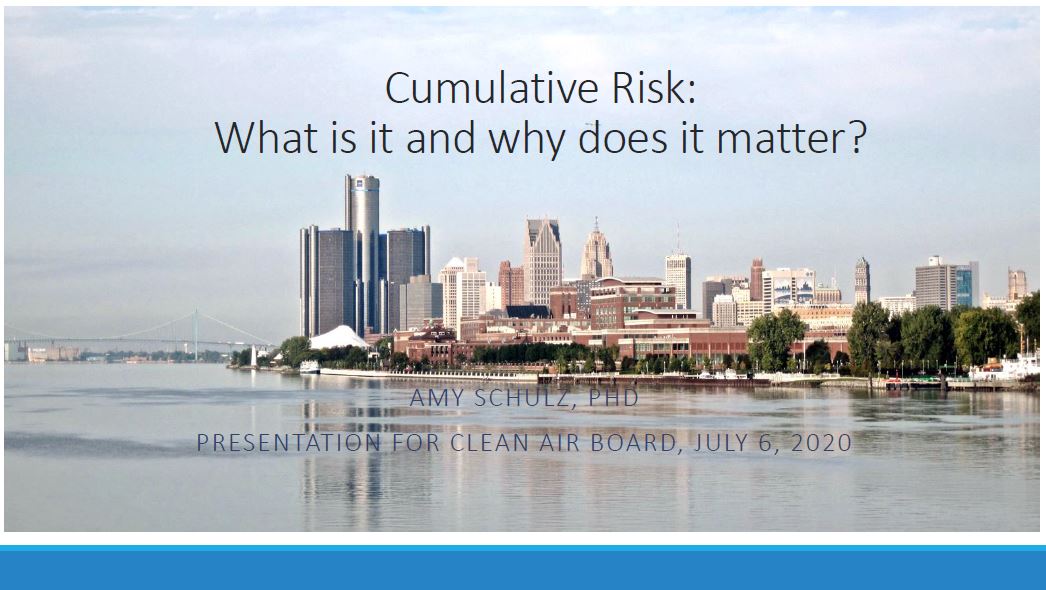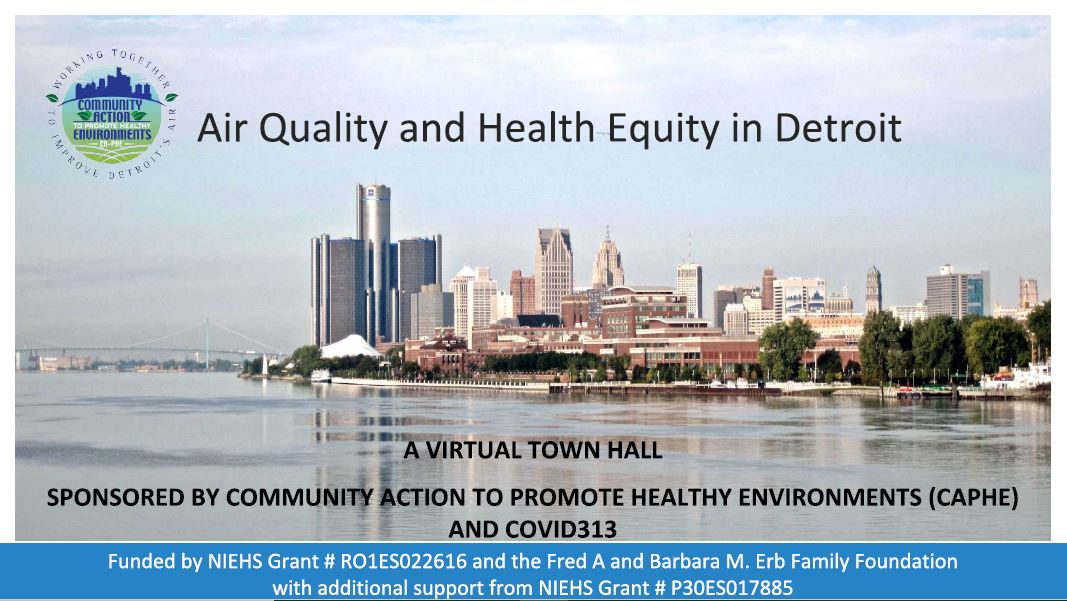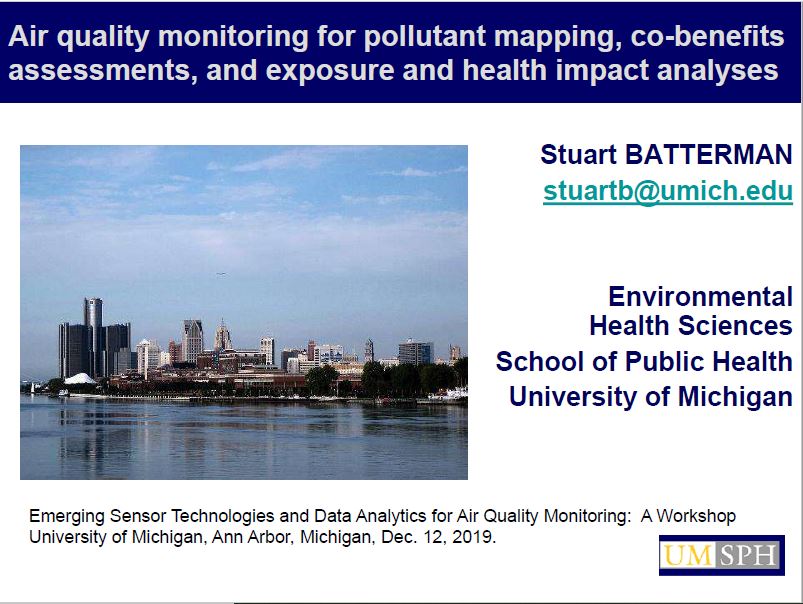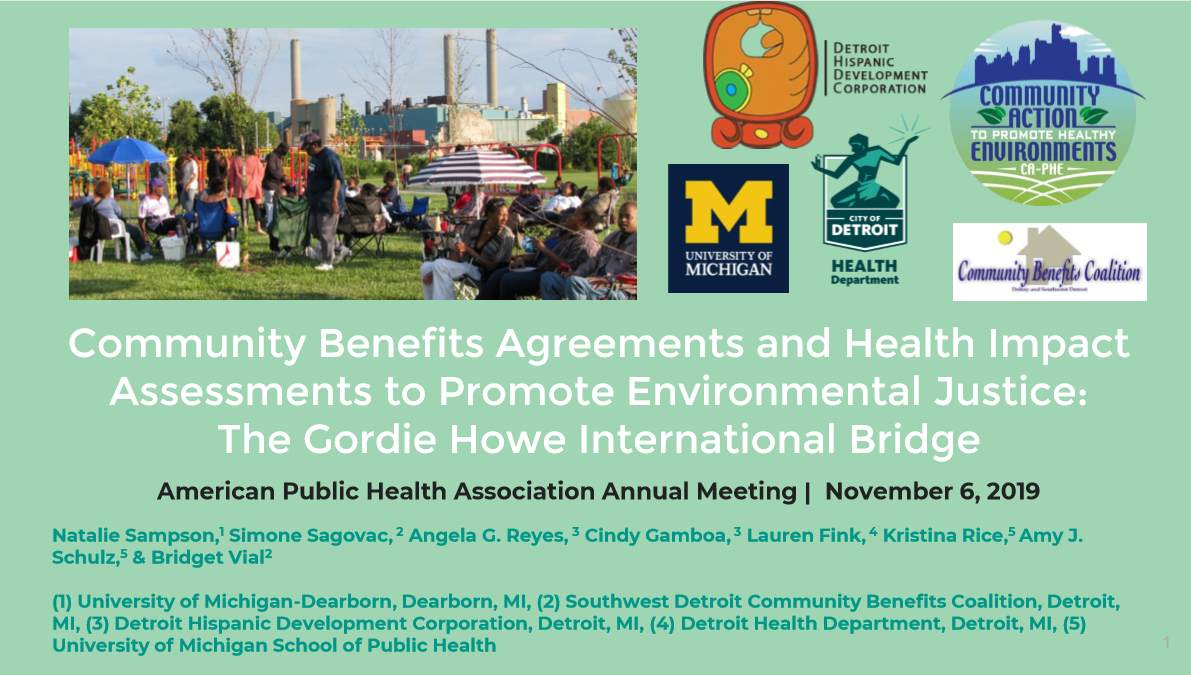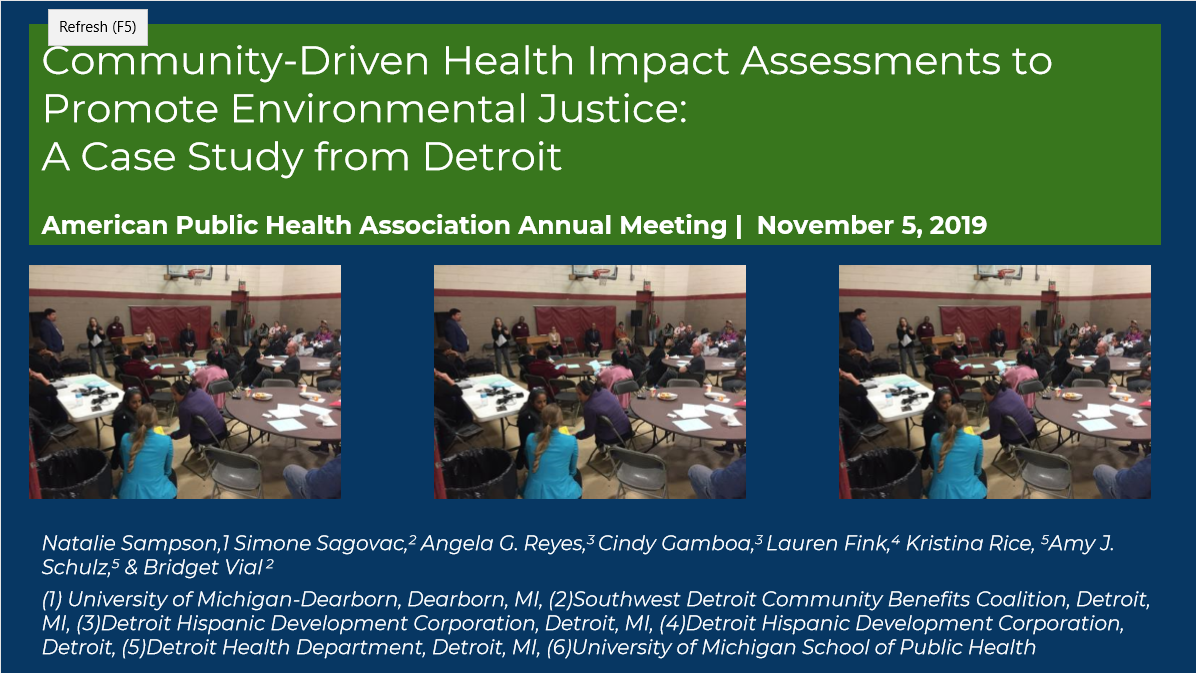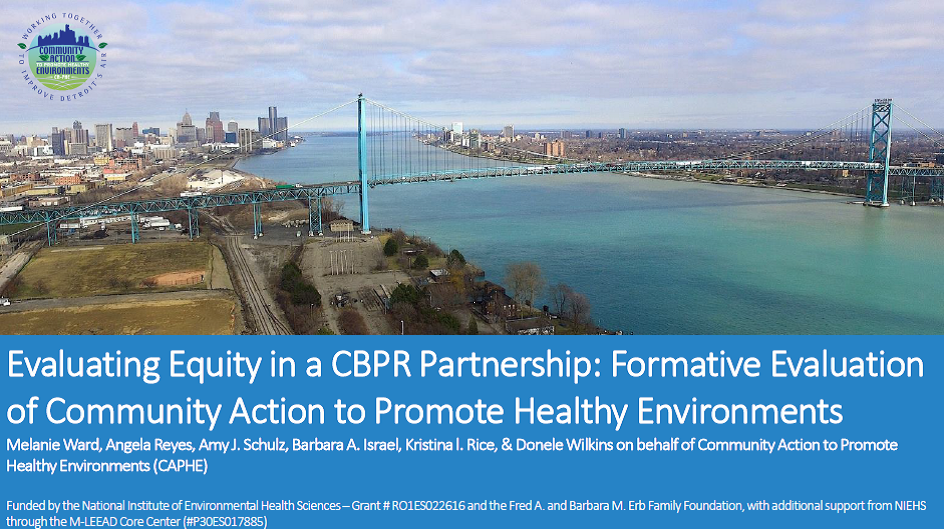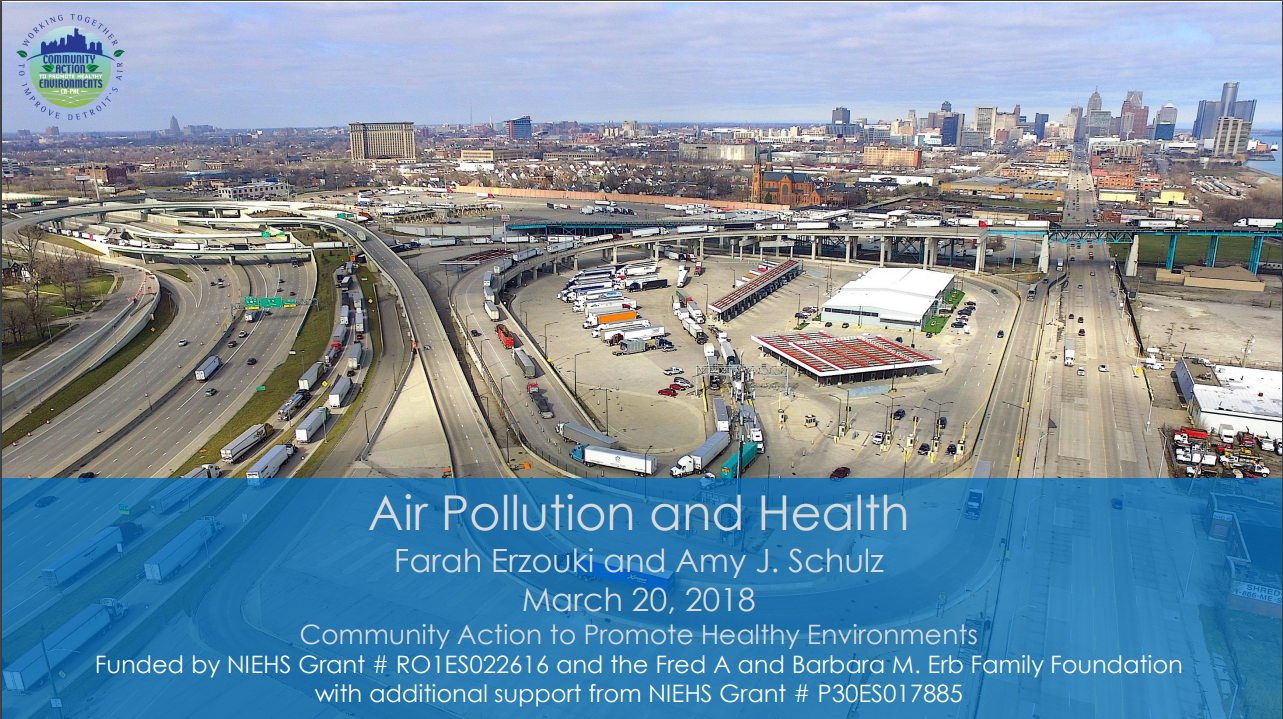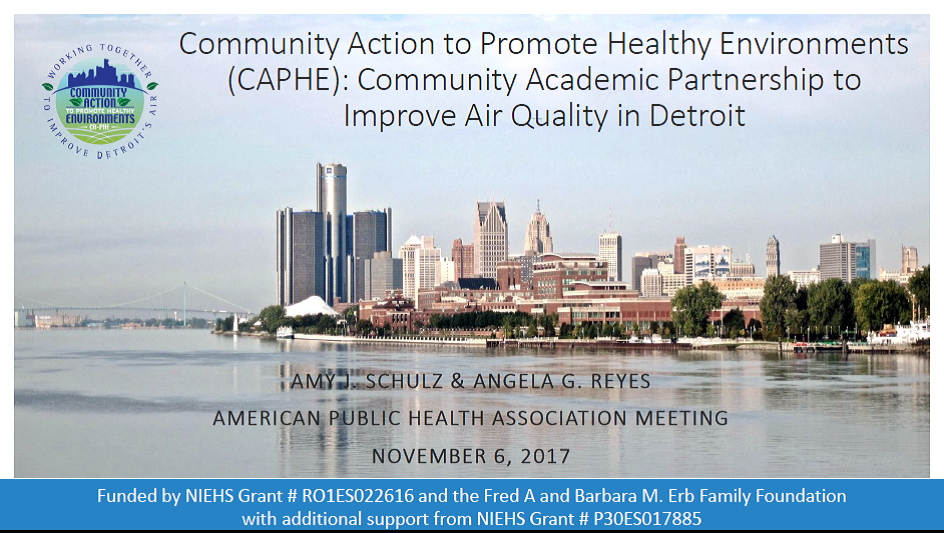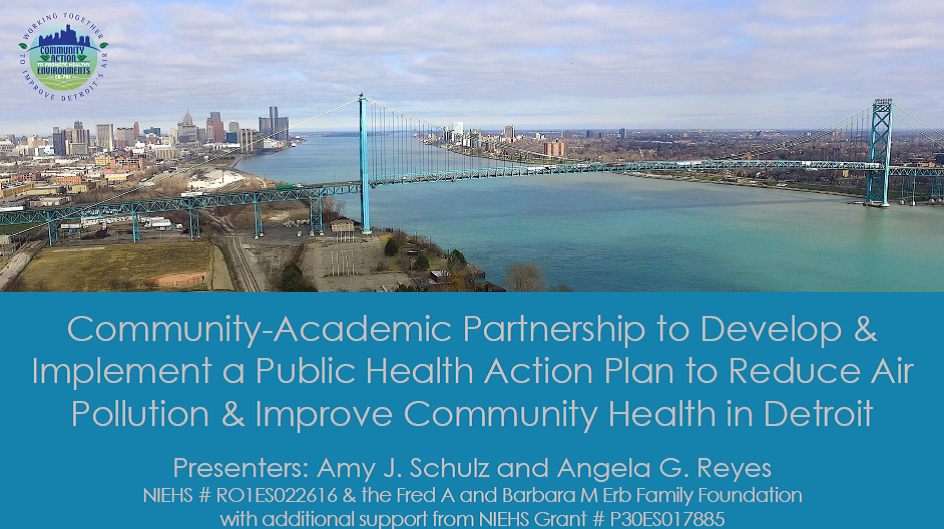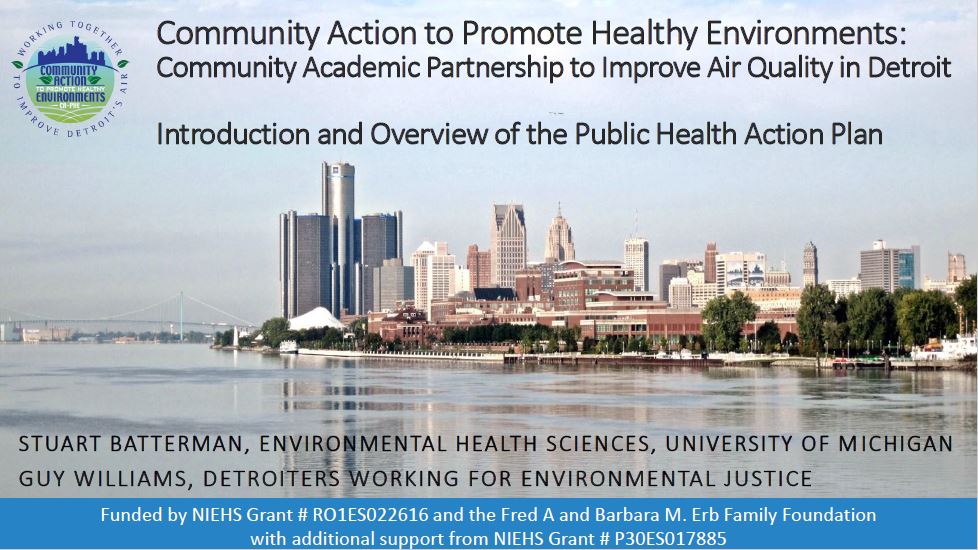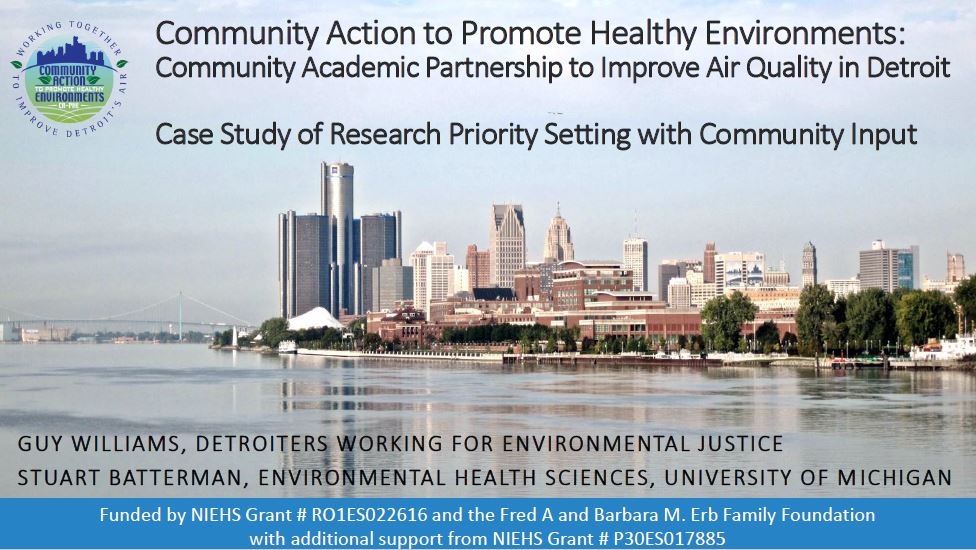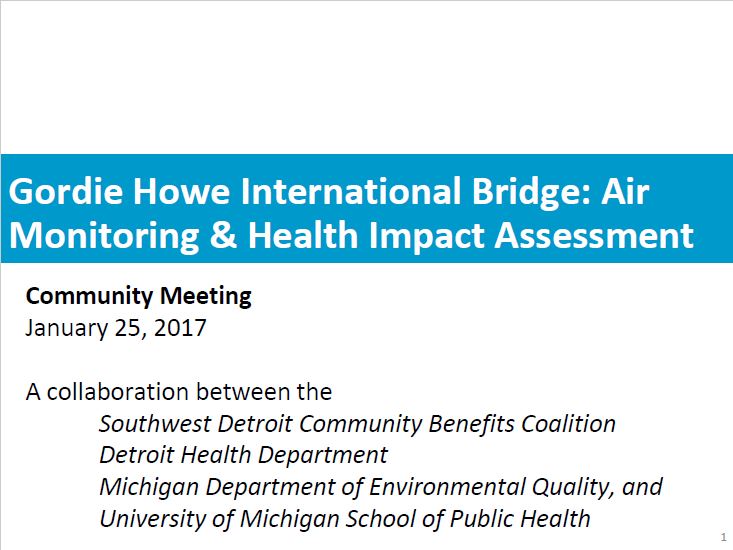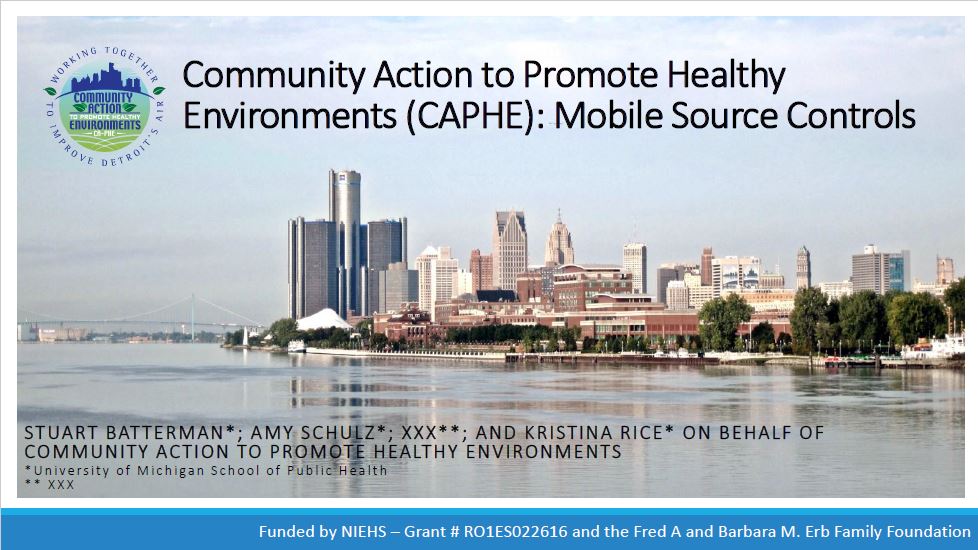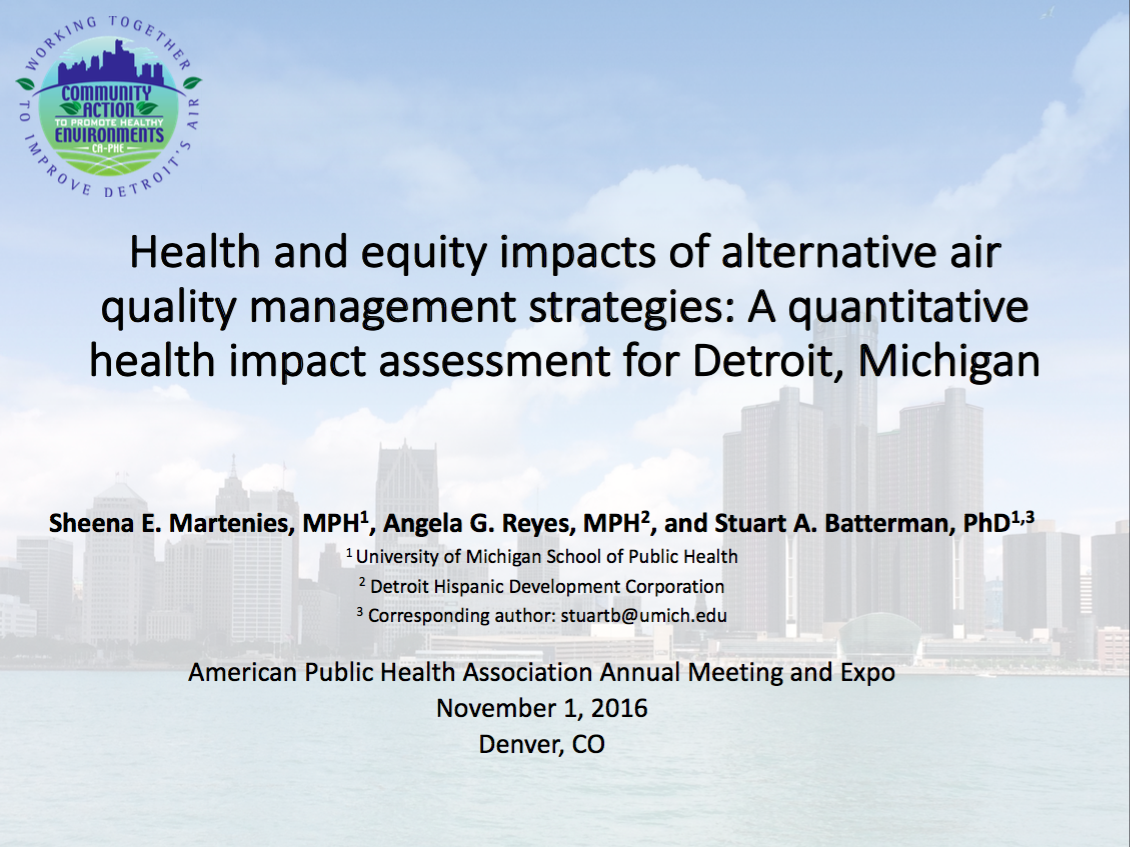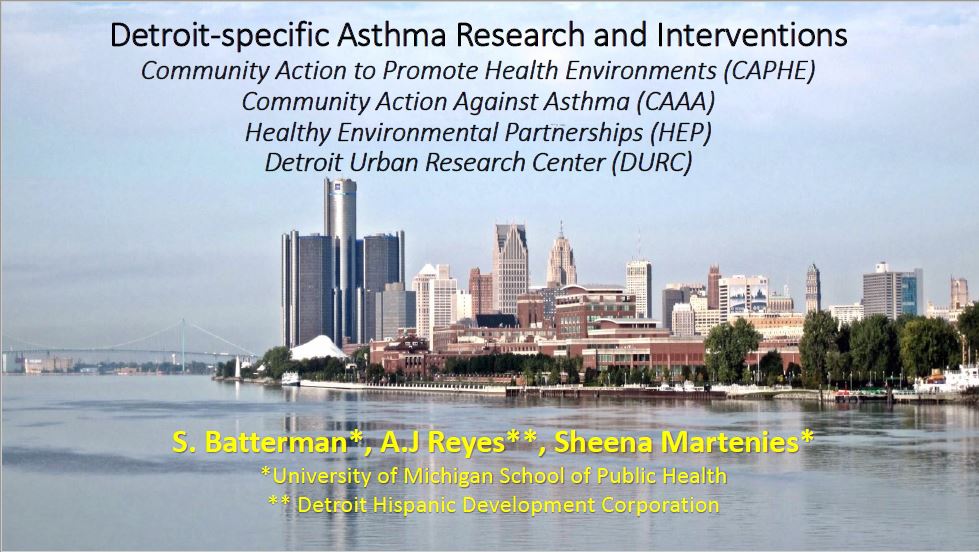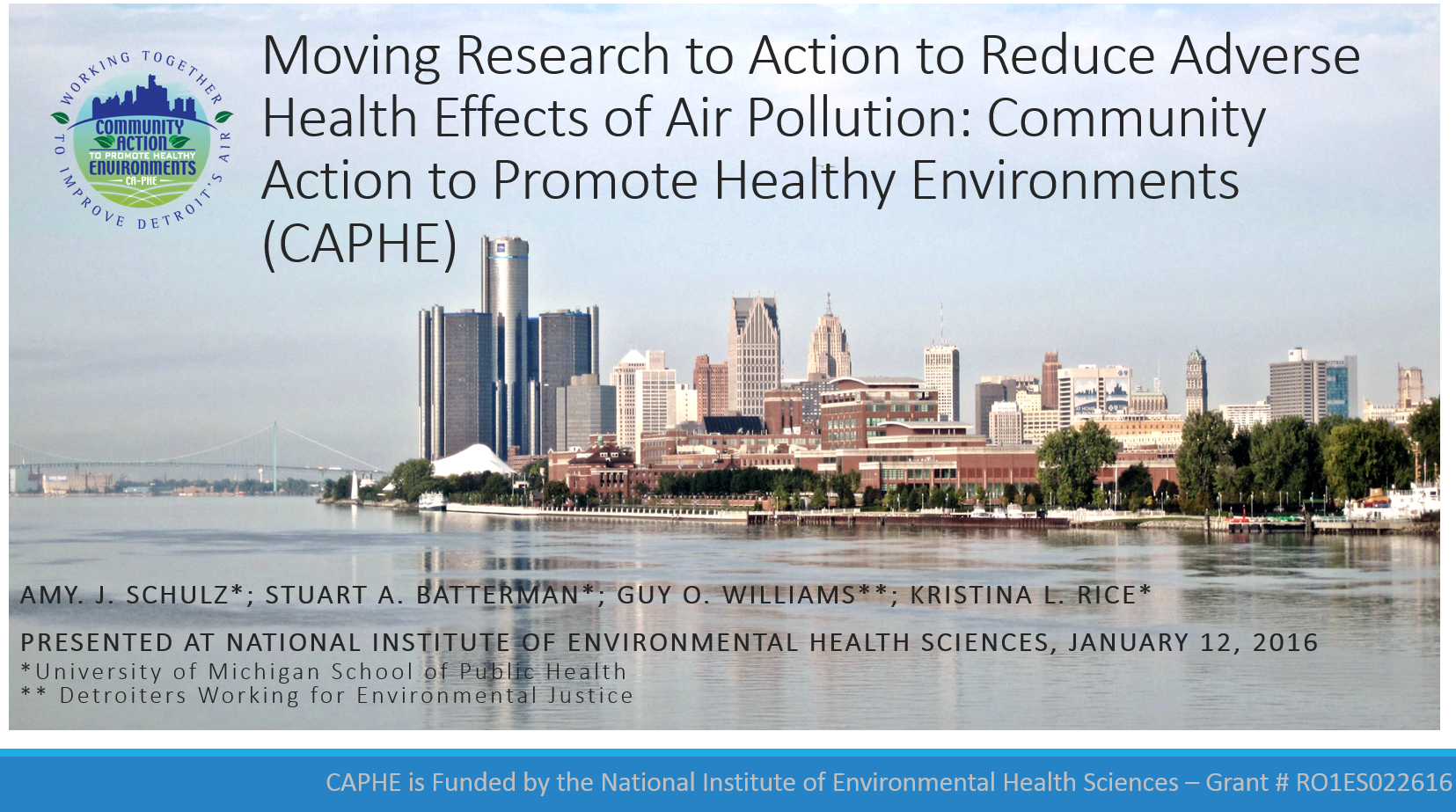Presentations
Dissemination and Translation for Policy Change: A Case Study from Community Action to Promote Healthy Environments (CAPHE) in Detroit
A.G. Reyes, A.J. Schulz, S. Batterman, B. Israel, K. Rice, M. Striz Calnin, G. Williams, D. Wilkins, N. Sampson
October 26, 2020 • American Public Health Association Meeting (APHA)
Provides overview of CAPHE’s goals and approach to working in partnership with Detroit-based organizations and communities. Presents quantified health impacts of air pollution in Detroit, and Resource Manual developed to discuss and identify key mitigation strategies with community organizations, community members, and City, State, and Federal representatives. Phases of developing the Resource Manual and related Public Health Action Plan are also described, with examples including scientifically-grounded, community-informed policy briefs, public comments, and health impact assessments.
Cumulative Risk: What is it and why does it matter?
A.J. Schulz
July 6, 2020 • Clean Air Board Meeting (Detroit, MI)
Presents concepts of cumulative risk, cumulative exposure, and their health implications in Detroit. Identifies priority communities for action by mapping hazardous facilities and land uses to reveal environmental exposures and health risks.
Air Quality and Health Equity in Detroit: CAPHE-COVID313 Virtual Townhall
S. Batterman, A.J. Schulz, M. Striz Calnin, D. Wilkins, K. Williams
May 15, 2020 • Detroit Public Television (DPTV)
Virtual townhall on Detroit’s air quality, health equity, and how to improve both. Actions to improve air quality and health equity include: use indoor air filters, monitor and enforce air pollution emissions, create spatial buffers, and enforce anti-idling ordinances. More detailed information about each speaker’s presentation can be found below, and a recording of the Virtual Townhall can be found here.
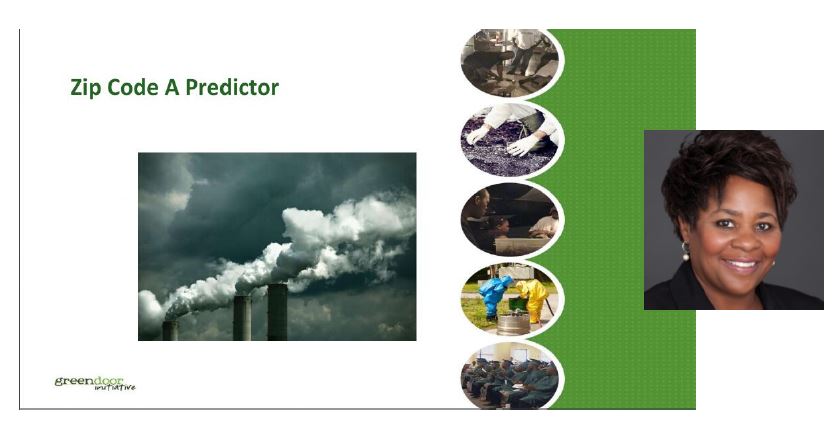
Donele Wilkins of Green Door Initiative speaks about air pollution, asthma, environmental justice, and cleaning products that are less harmful to human health during her portion of the presentation.
She speaks from 00:10:10 to 00:24:44 in the recording.
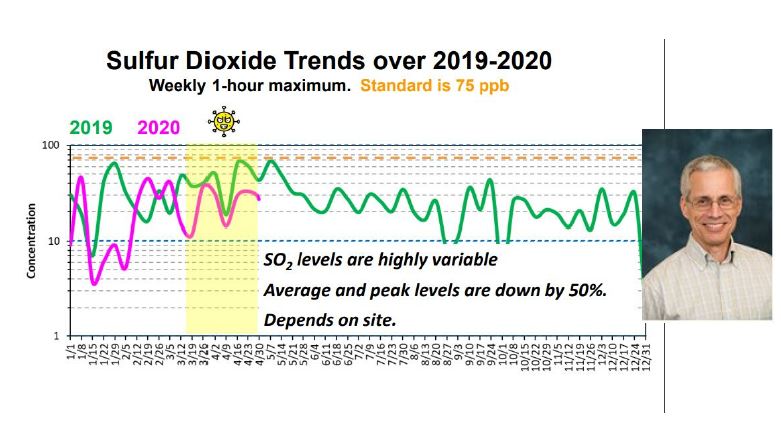
Stuart Batterman of the University of Michigan School of Public Health speaks about air quality monitoring in Detroit during his portion of the presentation.
He speaks from 00:24:55 to 00:41:59 in the recording.
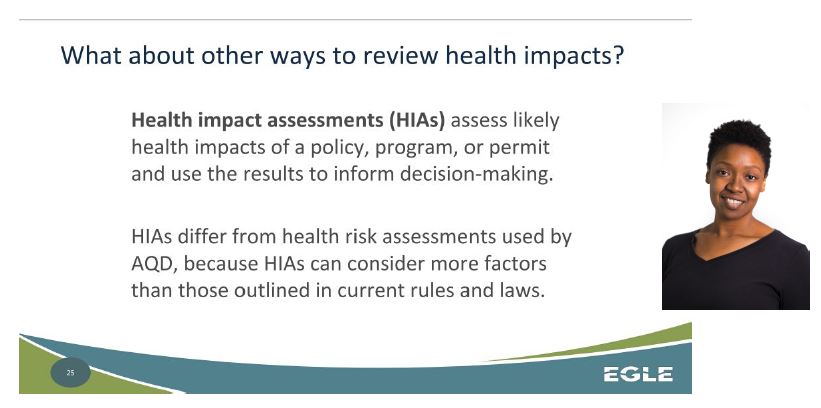
Keisha Williams of the Michigan Department of Environment, Great Lakes, and Energy (EGLE) speaks about health assessments during her portion of the presentation.
She speaks from 00:42:00 to 00:49:10 in the recording.

Amy Schulz of the University of Michigan School of Public Health speaks about cumulative risk and health impacts during her portion of the presentation.
She speaks from 00:49:21 to 01:01:47 in the recording.
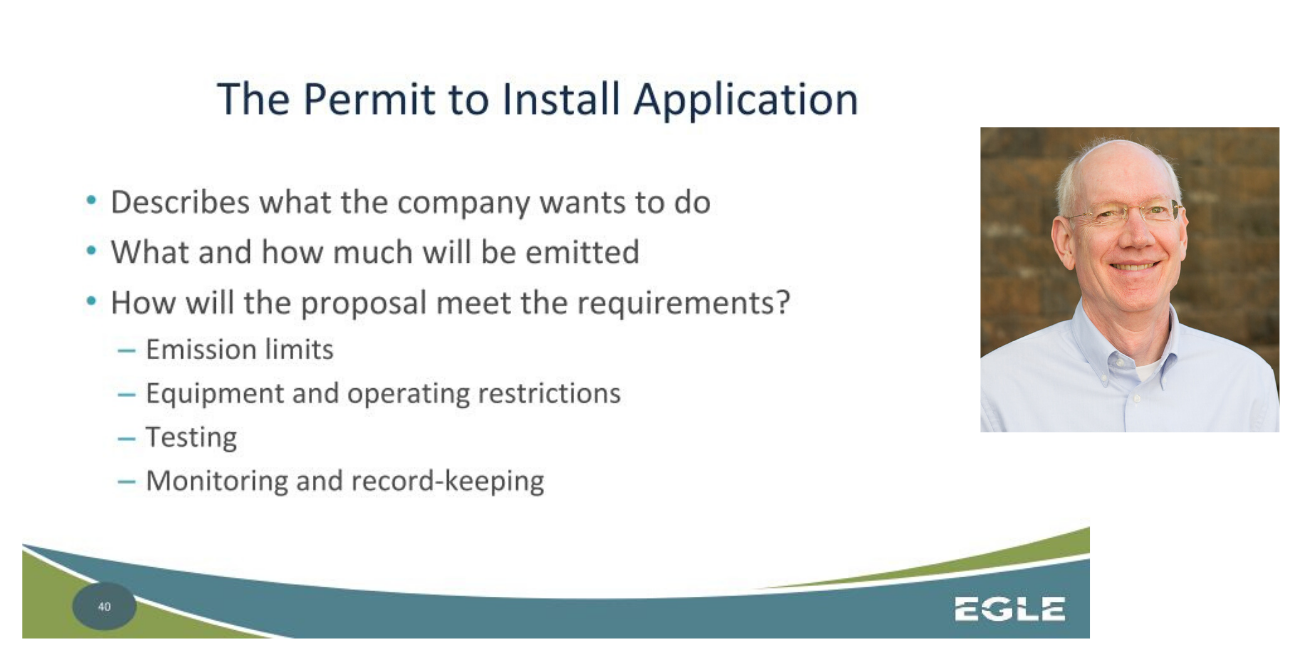
Paul Schleusener of the Michigan Department of Environment, Great Lakes, and Energy (EGLE) speaks about EGLE and air quality permitting during his portion of the presentation.
He speaks from 01:01:50 to 01:10:20 in the recording.
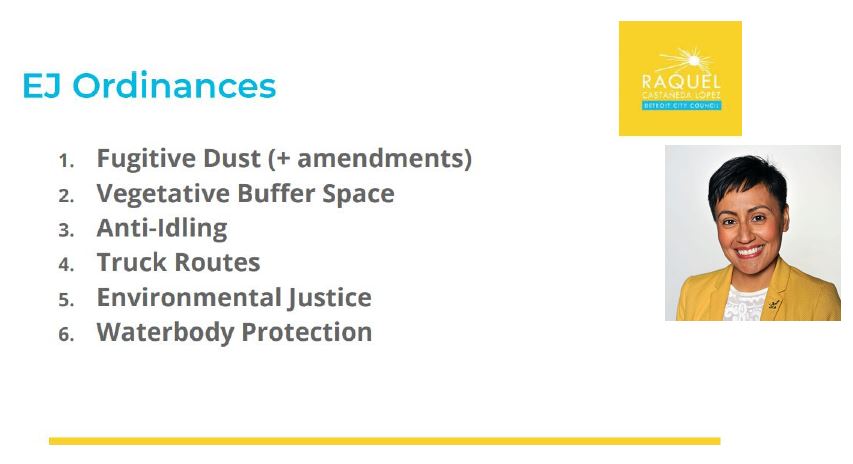
Raquel Castañeda López of Detroit’s City Council Distric 6 speaks about Detroit’s environmental justice ordinances during her portion of the presentation.
She speaks from 01:10:25 to 01:21:00 in the recording.

Maggie Striz Calnin of Southwest Detroit Environmental Vision (SDEV) speaks about working together to cut diesel air pollution in Detroit during her portion of the presentation.
She speaks from 01:21:05 to 01:31:00 in the recording.
Air Quality Monitoring for Pollutant Mapping, Co-Benefits Assessments, and Exposure and Health Impact Analyses
S. Batterman
December 12, 2019 • Emerging Sensor Technologies and Data Analytics for Air Quality Monitoring: A Workshop (Ann Arbor, MI)
Presents characteristics of air pollutant concentrations, background on ambient monitoring, and related approaches. To most appropriately assess exposure and health impacts, we need spatially-resolved information.
Community Benefits Agreements and Health Impact Assessments to Promote Environmental Justice: The Gordie Howe International Bridge (GHIB)
N. Sampson, S. Sagovac, A.G. Reyes, C. Gamboa, L. Fink, K.L. Rice, A.J. Schulz, B. Vial
November 6, 2019 • American Public Health Association Meeting (APHA)
Describes the process through which the Southwest Detroit Community Benefits Coalition negotiated a community benefits agreement that included conducting a three-phase health impact assessment (HIA). Presents the process and key findings from the first wave of the HIA, including recommendations for actions to reduce adverse health impacts of the GHIB.
Community-Driven Health Impact Assessments to Promote Environmental Justice: A Case Study from Detroit
N. Sampson, S. Sagovac, A.G. Reyes, C. Gamboa, L. Fink, K.L. Rice, A.J. Schulz, B. Vial
November 5, 2019 • American Public Health Association Meeting (APHA)
Presents process and key results from a community-driven health impact assessment (HIA), conducted at the request of Southwest Detroit Community Benefits Coalition, 2017-2019. Recommendations to reduce adverse health effects of the GHIB are presented, and informed by study findings, including resident concerns and suggestions for ways to address them.
Health Equity Evaluation of a Partnership to Promote Healthy Environments: Results from a Formative Evaluation
M. Ward, A.J. Schulz, B.A. Israel, K.L. Rice, D. Wilkins, A.G. Reyes
November 6, 2018 • American Public Health Association Meeting (APHA)
The conceptual framework and evaluation approach developed by CAPHE to promote equity in community-based participatory research (CBPR) was presented, with results from the 2018 partnership evaluation. Key findings presented to the partnership were shared, along with key actions identified by the partnership strengthen equity within the partnership as well as actions to promote equity more broadly.
Evaluating Equity in a CBPR Partnership: Formative Evaluation of Community Action to Promote Healthy Environments
M. Ward, A.G. Reyes, A.J. Schulz, B.A. Israel, K.L. Rice, D. Wilkins
November 6, 2018 • American Public Health Association Meeting (APHA)
Results from the first three waves of the evaluation of the CAPHE partnership were presented, along with key results from a focused discussion of those findings within the CAPHE Steering Committee. Key priorities that emerged included: raise awareness among groups facing inequities; engage communities and decision-makers; and utilize multiple strategies to promote equity.
Community Meeting: Air Pollution and Health
A.J. Schulz
March 20, 2018 • Salinas High School, CA
Described key air pollutants of concern in Detroit and related health impacts. Pollutants included PM2.5, SO2, CO, NOx, and ozone, with health impacts including respiratory, cardiovascular, and development. These impacts are responsible for hundreds of deaths, hospitalizations/ER visits, and missed school/work days for Detroit residents.
Excess Mortality Associated with Proximity to Freeways and Protective Effects of Vegetation in the Detroit Metropolitan Area: Examining the Distribution of Environmental Risk to Inform Public Health Action Planning
A.J. Schulz and A.G. Reyes
November 6, 2017 • American Public Health Association Meeting (APHA)
Described the distribution of exposures and protective factors by population characteristics and their association with cardiopulmonary mortality (CPM). We estimated reductions in CPM with reductions in air pollution and increases in trees. Finally, we presented recommendations for reducing harmful health impacts of air pollution based on these findings to recommendation in CAPHE’s Public Health Action Plan.
Community-Academic Partnership to Develop & Implement a Public Health Action Plan to Reduce Air Pollution & Improve Community Health in Detroit
A.J. Schulz and A.G. Reyes
November 4, 2017 • American Public Health Association Meeting (APHA)
Describes the process of developing CAPHE’s Public Health Action Plan (PHAP), which includes scientifically-based, community-informed and -prioritized recommendations to improve air quality. These recommendations inform our work with policy makers and policy makers and community groups to support actions consistent with the recommendations.
Introduction and Overview of the Public Health Action Plan
S. Batterman and G. Williams
May 24, 2017 • Natural Resources Committee Meeting
Provides an introduction and overview of CAPHE’s Public Health Action Plan (PHAP). We provide context on Detroit’s air quality, and key concepts in air quality science. Our Top 10 PHAP strategies to improve air quality are evidence-based and informed by community members, partner organizations, and researchers. We also share next steps in the PHAP, which include increasing engagement in campaigns, interventions, policies, and organizing.
Development of an Air Quality Action Plan for Detroit, Michigan
G. Williams and S. Batterman
May 17-20, 2017 • Citizen Science Association Meeting
Presents the process of setting research priorities during the development of CAPHE’s Public Health Action Plan (PHAP). After quantifying the health impacts on ambient exposures to air pollutants, we developed the Top 10 PHAP strategies.
Gordie Howe International Bridge: Air Monitoring & Health Impact Assessment
Southwest Detroit Community Benefits Coalition, Detroit Health Department, Michigan Department of Environmental Quality, University of Michigan School of Public Health
January 25, 2017 • Community Meeting (Detroit, MI)
Presents likely impacts on air quality and health of Detroit residents of building the Gordie Howe International Bridge. A community benefits agreement supports monitoring air quality at all stages of construction, and analysis and interpretation of findings.
Mobile Source Controls
S. Batterman, A.J. Schulz, K.L. Rice
January 24, 2017 • Community Meeting (Detroit, MI)
This presentation was discussion-based, focused on developing strategies for mobile source controls, synergies with current programs, and opportunities for collaboration. Recommendations include increasing use of clean fuels, retrofitting, and improving/increasing usage of public transit.
Health and Equity Impacts of Alternative Air Quality Management Strategies: A Quantitative Health Impact Assessment for Detroit, MI
S. Martenies, A.G. Reyes, S. Batterman
November 1, 2016 • American Public Health Association Meeting (APHA)
Presented findings from a quantitative health impact assessment (HIA). We examined the health and equity impacts of sulfur dioxide (SO2) emission control alternatives, and found the greatest reductions in health impacts and inequality come from targeting sources with larger health impacts per ton emitted first. By including HIAs in air quality management, we can help choose alternatives that simultaneously meet environmental, health, and equity goals.
Detroit-specific Asthma Research and Interventions
S. Batterman, A.G. Reyes, S. Martenies
May 11, 2016 • Detroit Asthma Summit
Presented on Detroit-specific asthma research and interventions. Some Detroit homes have high levels of mold, volatile organic compounds, and other particulate matter. Mitigation strategies include stand-alone and enhanced central furnace filters.
Moving Research to Action to Reduce Adverse Health Effects of Air Pollution
A.J. Schulz, S. Batterman, G. Williams, K.L. Rice
January 12, 2016 • National Institute of Environmental Health Sciences Meeting
Overview of CAPHE structure and goals, which center around creating an equitable partnership that engages community and academic partners in creating and implementing components of a scientifically-based, community-informed public health action plan to improve pollution and overall health in Detroit.

